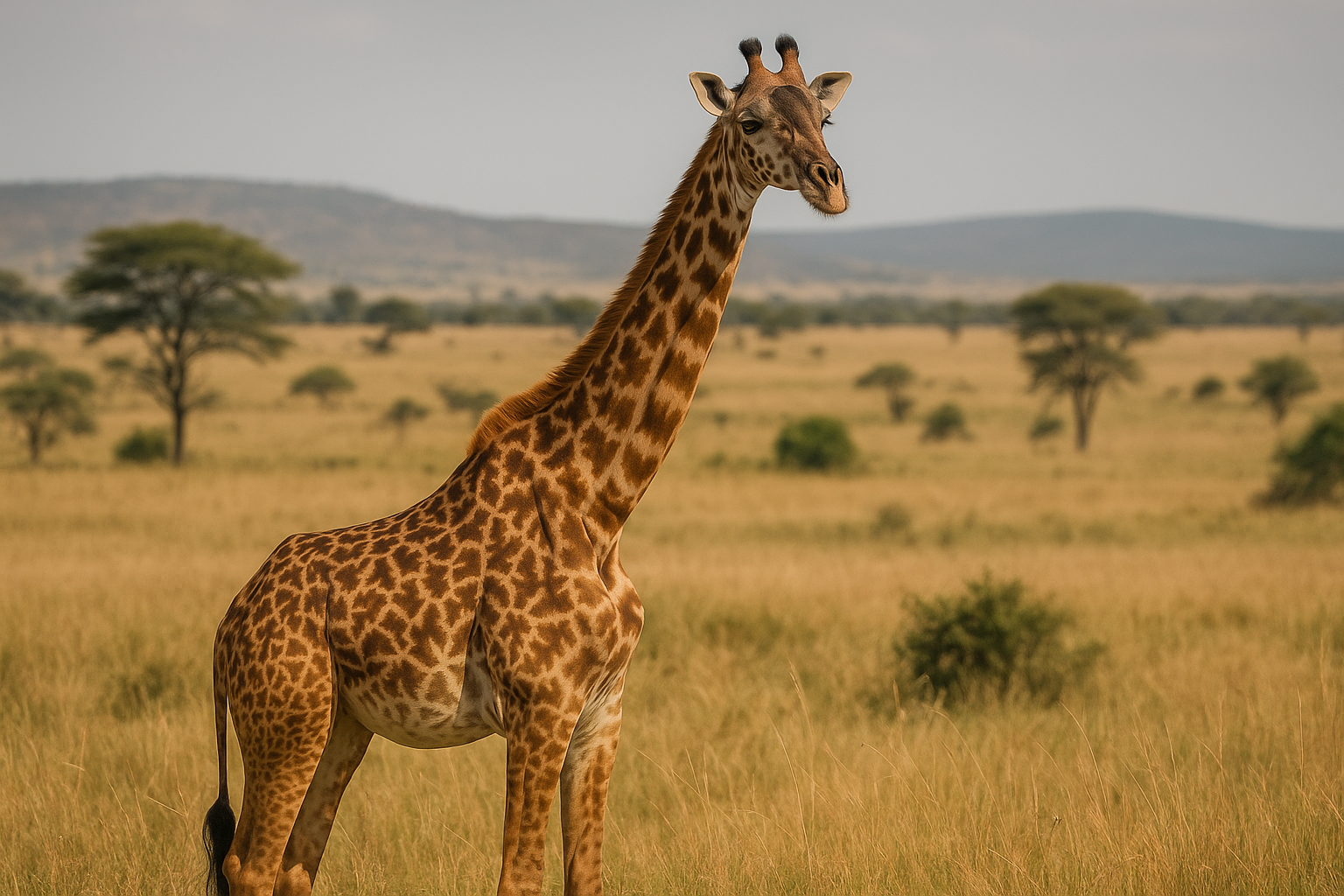Grace of the Savannah: The Untold Majesty of the Maasai Giraffe
Introduction: A Towering Emblem of Africa’s Heart
In the endless golden plains of East Africa, a shadow sways gently with the rhythm of the wind. It is not a tree. It is a giraffe—the Maasai giraffe, the tallest land animal on Earth and one of the most iconic symbols of the African savannah. With its unique jagged patches and towering stature, the Maasai giraffe is more than just a marvel of evolution—it is a gentle guardian of the acacia woodlands and an ecological pillar of its homeland.
Scientific Classification: The Architecture of a Giant
| Taxonomic Rank | Classification |
|---|---|
| Kingdom | Animalia |
| Phylum | Chordata |
| Class | Mammalia |
| Order | Artiodactyla |
| Family | Giraffidae |
| Genus | Giraffa |
| Species | Giraffa camelopardalis tippelskirchi |
Why this classification?
-
Kingdom Animalia: As a multicellular, heterotrophic organism with voluntary movement.
-
Phylum Chordata: It possesses a spinal cord and vertebrae.
-
Class Mammalia: Warm-blooded, hair-covered, and it gives live birth, nursing calves with milk.
-
Order Artiodactyla: Part of the even-toed ungulates (hooved animals like antelopes, buffalo, and deer).
-
Family Giraffidae: Shares this family only with the okapi.
-
Genus Giraffa: Distinguished by elongated necks and legs.
-
Subspecies Tippelskirchi: Named after German explorer von Tippelskirch, it’s the most populous and tallest giraffe subspecies.
Home of the Tallest: Natural Habitat
The Maasai giraffe is found primarily in southern Kenya and central to northern Tanzania, including prominent wildlife havens such as:
-
Serengeti National Park
-
Ngorongoro Conservation Area
-
Lake Manyara
-
Tarangire
-
Amboseli
They thrive in savannahs, open woodlands, and semi-arid regions, favoring areas rich with acacia trees, their primary source of food.
Physical Features: Designed by Nature’s Artist
The Maasai giraffe is instantly recognized by:
-
Dark, vine-like blotches with uneven edges that reach down to the hooves.
-
Males reach up to 5.9 meters (19 feet) in height, while females average 4.9 meters (16 feet).
-
Their tongues, reaching up to 45 cm (18 inches), are prehensile and darkly pigmented to protect against sunburn.
Every giraffe’s coat pattern is as unique as a fingerprint, offering camouflage and identity within herds.
Anatomy of Elevation: How the Giraffe Lives Tall
Despite their size, giraffes move with incredible grace, aided by an anatomical design of wonder:
1. The Neck
-
Despite being nearly 2 meters long, giraffes have only seven cervical vertebrae, like all mammals. Each vertebra is massive, connected by ball-and-socket joints to enable wide movement.
2. The Heart
-
A giraffe’s heart weighs 11 kilograms and is about 60 cm long, pumping blood with immense pressure to overcome gravity to reach the brain.
3. The Legs and Feet
-
Each leg is taller than an average adult human.
-
Leg arteries are reinforced to handle extreme pressure, and valves prevent blood from pooling.
4. The Ossicones
-
Horn-like protrusions covered in skin and hair. In males, they grow thicker and bald on top from fighting.
Feeding Behavior: Life at the Top
Giraffes are browsers, feeding on:
-
Acacia leaves, rich in moisture and protein.
-
Twigs, fruits, and flowers.
-
They consume about 34 kilograms of vegetation daily.
With their long necks and tongues, they feed high above the reach of most herbivores, reducing food competition. Their thick lips and tough palate allow them to eat thorny acacia without injury.
Social Structure and Communication
Maasai giraffes live in loosely structured herds that change frequently.
-
Females and calves often group together, while males roam alone or in bachelor herds.
-
They are non-territorial and communicate through low-frequency sounds, sometimes inaudible to humans.
-
Necking—a ritual combat between males—is a form of establishing dominance, involving swinging necks like battering rams.
Reproduction and Calf Development
Mating and Gestation
-
Dominant males court females in estrus using flehmen response—curling their lips to sense pheromones.
-
Gestation lasts ~15 months.
-
A single calf is born, usually around 1.8 meters tall, able to stand and walk within 30 minutes.
Maternal Behavior
-
Calves are hidden in vegetation while mothers forage.
-
They are extremely vulnerable to predators—lions, hyenas, and leopards being their main threats.
-
Calves grow rapidly and are weaned by 12–18 months.
The Ecological Role of Maasai Giraffes
Giraffes are keystone species. Their browsing:
-
Shapes tree growth patterns.
-
Opens the canopy for smaller species.
-
Disperses seeds via dung.
-
Provides food for oxpeckers and other mutualistic birds.
Their survival affects the balance of the entire savannah.
Predators, Threats, and Defenses
Natural Predators
-
Adult giraffes are preyed on mainly by lions, especially at waterholes.
-
Calves fall victim to hyenas, leopards, and even wild dogs.
Defensive Tactics
-
Powerful kicks (can crush a lion’s skull).
-
Height advantage to spot danger early.
-
Stay in herds for safety in numbers.
Conservation Status: A Silent Decline
The Maasai giraffe is listed as Endangered by the IUCN.
Major Threats:
-
Habitat loss from agriculture and urban expansion.
-
Poaching for bushmeat, skin, and tail hair.
-
Climate change affecting acacia growth and migration routes.
-
Human-wildlife conflict near villages and farms.
Conservation Efforts:
-
Protected within Tanzania and Kenya’s national parks.
-
Community-based conservation and ecotourism.
-
Research and population monitoring by organizations like the Giraffe Conservation Foundation.
Cultural and Symbolic Value
To the Maasai people, giraffes represent:
-
Peace and calmness
-
Their walking is said to bring “messages from the sky”
-
Their hides and tails were once used in traditional ceremonies—though now discouraged to protect the species.
Unique and Fascinating Facts
-
Giraffes have the same number of neck vertebrae as humans—just much larger.
-
Their sleep duration is among the shortest of mammals—only 5 to 30 minutes per day.
-
Their walking pattern is called a “pacing gait”—moving both legs on one side simultaneously.
-
Despite their necks, they can’t reach the ground without awkwardly spreading their front legs.
-
They’ve been observed displaying mourning behaviors for deceased herd members.
The Future of the Maasai Giraffe
In a world of shrinking wildlands, the Maasai giraffe’s future depends on our actions. Preserving their corridors, protecting calves, involving local communities, and raising global awareness are vital.
A world without giraffes would not only be less majestic—it would be ecologically poorer.
Conclusion: Sentinels of the Savannah
The Maasai giraffe is more than a graceful giant—it is a living sculpture, a gentle spirit, and a beacon of Africa’s wild beauty. Watching one move across the horizon is like watching nature compose poetry.
Let us walk beside them—not just in admiration, but in responsibility.








No comments:
Post a Comment